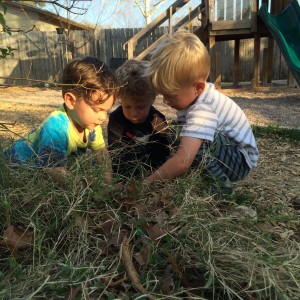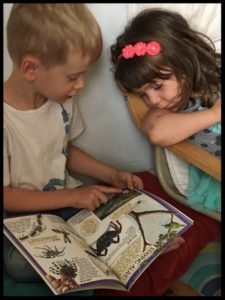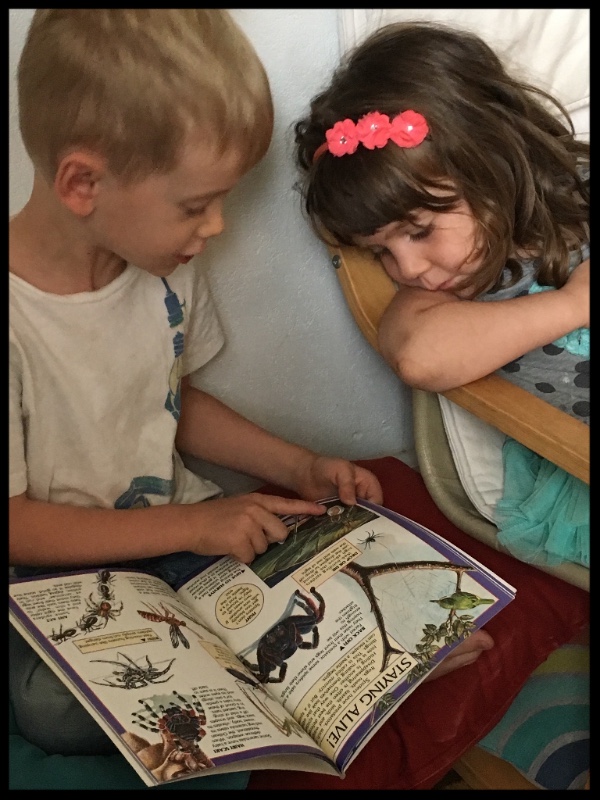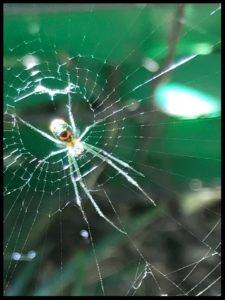“Sarah! There is a spider in the library!”
 So goes a not uncommon announcement heard around our classroom this year. Such announcement is not uttered out of fear but out of excitement and a sense of discovery. Our young students have come to admire and like spiders over the many months of school.
So goes a not uncommon announcement heard around our classroom this year. Such announcement is not uttered out of fear but out of excitement and a sense of discovery. Our young students have come to admire and like spiders over the many months of school.
Way back in September the announcement of finding an arachnid anywhere within the school premises was a warning that some menacing, highly-feared creepy crawly was on the prowl. Back then the teachers made sure to explain to the children that while we don’t want to touch them, spiders are not “dangerous” and that many of them are very helpful to the environment.
The children were given lessons on how to handle a spider by brushing it into a cup and put it gently outside on the playground. As the year progressed, spiders made their appearances every now and then, and the children’s announcements kept coming. But they became more like “Sarah! There is a spider under the shelf, we need to take it outside.” Or, “Look, it’s a jumping spider! It’s nice. Be careful don’t hurt it.”
 With each spider delivered to the playground, the children’s curiosity grew. Instead of ushering the spiders outside, they started observing them whenever they had a chance. There were debates and discussion about whether spiders were venomous. First, the children decided that maybe the darker the spider the more poisonous it is, or perhaps it’s the bigger spiders are the most poisonous. Books on Spiders were helpful, the children loved their debates and coming to conclusions on their own. Finally the children decided that not all spiders were venomous.
With each spider delivered to the playground, the children’s curiosity grew. Instead of ushering the spiders outside, they started observing them whenever they had a chance. There were debates and discussion about whether spiders were venomous. First, the children decided that maybe the darker the spider the more poisonous it is, or perhaps it’s the bigger spiders are the most poisonous. Books on Spiders were helpful, the children loved their debates and coming to conclusions on their own. Finally the children decided that not all spiders were venomous.
By springtime, a new thing captured their interest; spider webs. The children observed spiders in their webs. After a couple of attempts of touching the frail structures, the children figured out that spider webs are very fragile and should only be looked at.
This month, a classic round web appeared in a far corner of the playground (photo, right). The children checked on it everyday. They loved talking about it and kept updating each other on how the web is doing. The children’s fascination was tremendous as they started noticing the bugs stuck to the spider web. They came to the conclusion that spider webs are sticky, until one day they noticed how the spider moved freely about its web.
The question one of the older children asked then was “Why doesn’t he get stuck on the web?”A teacher explained through a guided discussion and drawings in the dirt as to how spider webs work. And as they observed the web on the playground the children were able figure out which were the sticky and the non-sticky parts on the web, and pass the knowledge on to other children who were not there for the teacher’s discussion.
The beauty of these anecdotes is the children’s dedication to discovering the world around them. The sharing of knowledge among the multiple ages as the older ones pass along the info to the younger ones. The children’s autonomy of seeking knowledge by interacting with and observing the subject of their curiosity instead of relying only on information from adults or books. All such discoveries were owned by the children and their pure love for learning.

